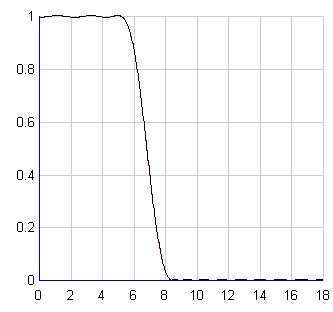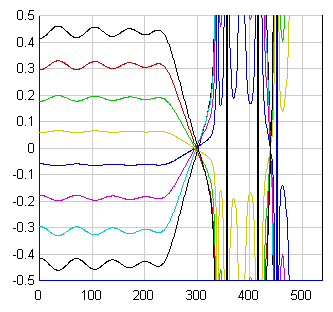This page shows the response curves of the main filters used in Richard Russell's Colour Recovery process (software versions 1.30a and later; in earlier versions the chrominance bandpass filters were wider: the horizontal filter having a -6dB bandwidth of about 1.4 MHz and the vertical filters a -6dB bandwidth of about 65 c/aph).
Horizontal chrominance filter[]
The horizontal chrominance filter is a 63-tap optimised bandpass FIR centered on 4.433 MHz and with a -6dB bandwidth of approximately 1.1 MHz:
Vertical chrominance filter (LF)[]
The low-frequency vertical chrominance filter is a 47-tap optimised bandpass FIR centered on 72 c/aph and with a -6dB bandwidth of approximately 44 c/aph:
Vertical chrominance filter (HF)[]
The high-frequency vertical chrominance filter is a 47-tap optimised bandpass FIR centered on 216 c/aph and with a -6dB bandwidth of approximately 44 c/aph:
Luminance downconversion filter (horizontal)[]
The horizontal luminance downconversion filter (36.0 to 13.5 MHz) is a 31-tap, 3-phase optimised lowpass FIR with a -6dB bandwidth of approximately 6.75 MHz. The group delay response (in samples) of the three phases is also shown:
Luminance downconversion filter (vertical)[]
The vertical luminance downconversion filter (1080 to 576 c/aph) is a 31-tap, 8-phase optimised lowpass FIR with a -6dB bandwidth of approximately 288 c/aph. The group delay response (in samples) of the eight phases is also shown:
UV separation filter[]
The UV separation filter is a 2-dimensional FIR with the response shown below, where blue regions indicate routing to the U output and red regions indicate routing to the V output. The axes correspond to –18 to +18 MHz horizontally and –540 to +540 c/aph vertically, with zero frequency in the centre:
Overall 2D response[]
The overall 2-dimensional frequency response arising from the composite effects of the above filters can be seen from the output image below, generated from a circular zone-plate source:
 The performance of the luminance down-conversion filters can be assessed from the monochrome zone-plate output, and the effects of the horizontal and vertical chrominance filters (and the UV separation filter) can be seen in the coloured regions. The axes correspond to –18 to +18 MHz horizontally and –540 to +540 c/aph vertically, with zero frequency in the centre.
The performance of the luminance down-conversion filters can be assessed from the monochrome zone-plate output, and the effects of the horizontal and vertical chrominance filters (and the UV separation filter) can be seen in the coloured regions. The axes correspond to –18 to +18 MHz horizontally and –540 to +540 c/aph vertically, with zero frequency in the centre.







